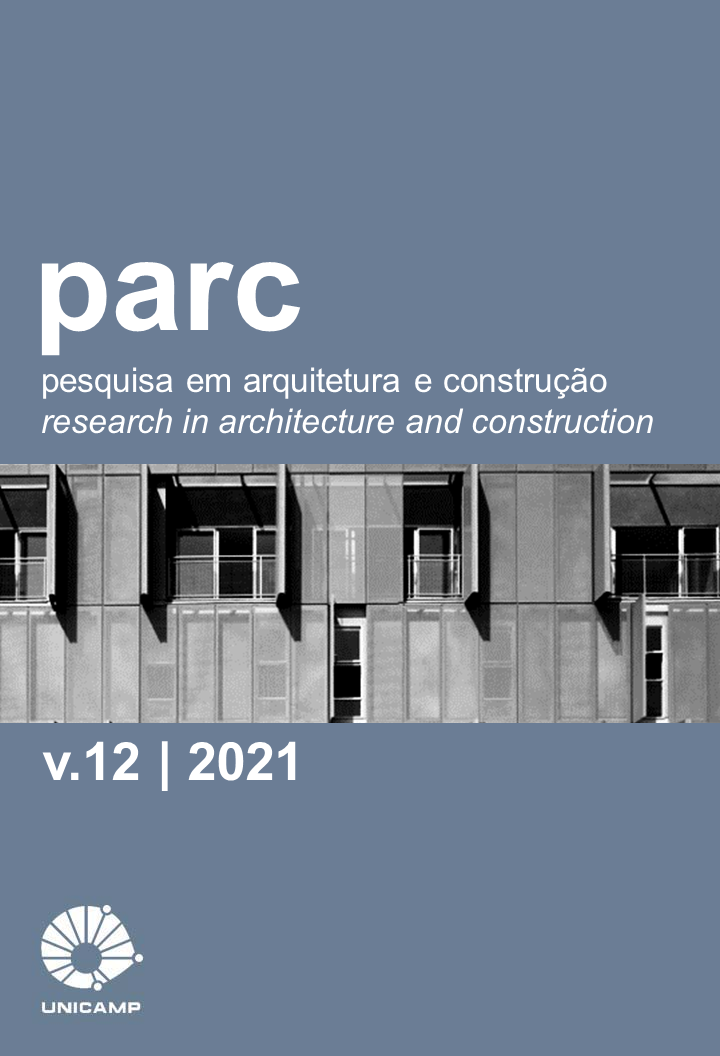Abstract
The demand for energy in buildings is a worldwide research subject due to its importance in the global electric load share. Besides, photovoltaic conversion to generate electricity locally is one of the ways to meet that demand. This work aims to evaluate the application of semi-transparent photovoltaic glass on a skylight of a commercial building and estimate electricity consumption and production using computational simulation with EnergyPlus. The opening size was set as a variable parameter. Its performance was compared to an ordinary skylight and opaque modules under the same conditions for three different Brazilian bioclimatic zones. Results show that the area's change provided significant differences in generation and less important ones in consumption. Among the bioclimatic zones, the building presented the lowest consumption and the highest generation for all configurations in the coldest zone, making it the best region for net electricity, i.e., purchased from a utility. Comparing semi-transparent with opaque modules, the latter produced much more energy, but consumption was reduced by an average of 28% in favour of the photovoltaic glass. The main conclusion is that the use of photovoltaic technology in a semi-transparent glass is promising regarding the integration of generators to the building, but the efficiency rates need to increase to bring it closer to opaque modules in performance.
References
ASSOCIAÇÃO BRASILEIRA DE NORMAS TÉCNICAS. NBR 15220: desempenho térmico de edificações. Parte 3: zoneamento bioclimático brasileiro e diretrizes construtivas para habitações unifamiliares de interesse social. Rio de Janeiro: ABNT, 2005a.
ASSOCIAÇÃO BRASILEIRA DE NORMAS TÉCNICAS. NBR 15220: desempenho térmico de edificações. Parte 2: métodos de cálculo da transmitância térmica, da capacidade térmica, do atraso térmico e do fator solar de elementos e componentes de edificações. Rio de Janeiro: ABNT, 2005b.
ASSOCIAÇÃO BRASILEIRA DE NORMAS TÉCNICAS. NBR 16401: instalações de ar-condicionado: sistemas centrais e unitários. Parte 1: projetos das instalações. Rio de Janeiro: ABNT, 2008a.
ASSOCIAÇÃO BRASILEIRA DE NORMAS TÉCNICAS. NBR 16401: instalações de ar-condicionado: sistemas centrais e unitários. Parte 2: parâmetros de conforto térmico. Rio de Janeiro: ABNT, 2008b.
ASSOCIAÇÃO BRASILEIRA DE NORMAS TÉCNICAS. NBRISO/CIE8995: iluminação de ambientes de trabalho. Parte 1: interior. Rio de Janeiro: ABNT, 2013.
ASSOCIAÇÃO BRASILEIRA DE NORMAS TÉCNICAS. NBR 7199: vidros na construção civil: projeto, execução e aplicações. Rio de Janeiro: ABNT, 2016.
BERKELEY LAB. OPTICS v.6.0. [S.l.]: LBNL, 2013. Available at: https://windows.lbl.gov/software/optics. Accessed: 9 Sept. 2018.
BERKELEY LAB. WINDOW v7.7.07 IGDB v 68.0.0. [S.l.]: LBNL, 2019. Available at: https://windows.lbl.gov/software/window. Accessed: 1 Aug. 2019.
BIG LADDER SOFTWARE. Euclid. [S.l.: s.n.], 2017. Available at: https://bigladdersoftware.com/projects/euclid. Accessed: 20 Oct. 2018.
CUSTÓDIO, I. P.; RÜTHER, R. Influência da integração de energia fotovoltaica a uma edificação na sua temperatura interna e no consumo energético da rede elétrica pública. In: ENCONTRO NACIONAL DE CONFORTO NO AMBIENTE CONSTRUÍDO. 14., 2017, Balneário Camboriú. Anais[...]. Balneário Camboriú: ANTAC, 2017.
DIDONÉ, E. L. Parametric study for net zero energy building strategies in Brazil considering semi-transparent PV windows. Karlsuhe, 2014. 212 p. Thesis (Doctor in Engineering) – Department of Architecture, Karlsruhe Institute of Technology, Karlsuhe, Germany, 2014. Available at: https://publikationen.bibliothek.kit.edu/1000044721. Accessed: 14 July 2018.
EMPRESA DE PESQUISA ENERGÉTICA. Balanço Energético Nacional 2019: Ano base 2018. Rio de Janeiro: EPE, 2019. Available at: http://www.epe.gov.br/pt/publicacoes-dados-abertos/publicacoes/balanco-energetico-nacional-2019. Accessed: 22 Dec. 2019.
HANSEN, C. W. et al. Calibration of Photovoltaic Module Performance Models. In: WORLD CONFERENCE ON PHOTOVOLTAIC ENERGY CONVERSION. 6., 2014, Kyoto. Proceedings [...]. Kyoto, Japan: [s.n.], 2014. Available at: https://energy.sandia.gov/wp-content/gallery/uploads/5DV3_56_paper.pdf. Accessed: 9 Sept. 2018.
INSTITUTO BRASILEIRO DE GEOGRAFIA E ESTATÍSTICA. Mapa político do Brasil. [S.l.]: IBGE, 2019. Available at: https://portaldemapas.ibge.gov.br/portal.php#homepage. Accessed: 2 Aug. 2019.
INSTITUTO NACIONAL DE METROLOGIA, NORMALIZAÇÃO E QUALIDADE INDUSTRIAL. Regulamento Técnico da Qualidade para o Nível de Eficiência Energética de Edificações Residenciais. Rio de Janeiro: INMETRO, 2012. Available at: http://www.pbeedifica.com.br/sites/default/files/projetos/etiquetagem/residencial/downloads/RTQR.pdf. Accessed: 29 July 2018.
INSTITUTO NACIONAL DE METROLOGIA, NORMALIZAÇÃO E QUALIDADE INDUSTRIAL. Regulamento Técnico da Qualidade para o Nível de Eficiência Energética de Edificações Comerciais, de Serviços e Públicas. Rio de Janeiro: INMETRO, 2013. Available at: http://www.pbeedifica.com.br/sites/default/files/projetos/etiquetagem/comercial/downloads/Port372-2010_RTQ_Def_Edificacoes-C_rev01.pdf. Accessed: 29 July 2018.
JELLE, B. P. Building integrated photovoltaics: a concise description of the current state of the art and possible research pathways. Energies, v. 9, n. 1, p. 1–30, 2016. DOI: https://doi.org/10.3390/en9010021.
KING, D. L.; BOYSON, W. E.; KRATOCHVIL, J. A. Photovoltaic Array Performance Model. Sandia Report nº 2004-3535, v. 8, n. December, p. 1–19, 2004. DOI: https://doi.org/10.2172/919131.
LABORATÓRIO DE EFICIÊNCIA ENERGÉTICA EM EDIFICAÇÕES. Arquivos climáticos INMET 2012. Florianópolis: UFSC/LabEEE, 2012. Available at: http://www.labeee.ufsc.br/downloads/arquivos-climaticos/formato-epw. Accessed: 9 Sept. 2018.
LI, D. H. W. et al. Energy and cost analysis of semi-transparent photovoltaic in office buildings. Applied Energy, v. 86, n. 5, p. 722–729, 2009. DOI: https://doi.org/10.1016/j.apenergy.2008.08.009.
NATIONAL RENEWABLE ENERGY LABORATORY. Sandia PV module database - library editor of System Advisor Model (SAM). [S.l.]: NREL, 2014.
ORDENES, M. et al. Metodologia utilizada na elaboração da biblioteca de materiais e componentes construtivos brasileiros para simulações no VisualDOE-3.1. Florianópolis: UFSC/LabEEE, 2003. Available at: http://www.labeee.ufsc.br/node/266. Accessed: 9 Sept. 2018.
PENG, J. et al. Validation of the Sandia model with indoor and outdoor measurements for semi-transparent amorphous silicon PV modules. Renewable Energy, v. 80, p. 316–323, 2015. DOI: https://doi.org/10.1016/j.renene.2015.02.017.
PENG, J. Consult about SAPM parameters. Personal message. Hong Kong, China, 2018.
REN21. Renewables 2019 Global Status Report. Paris: REN21, 2019. Available at: https://www.ren21.net/gsr-2019. Accessed: 5 July 2019.
TRIMBLE NAVIGATION LIMITED. SketchUp Make 2016. [S.l.: s.n.], 2016. Available at: https://www.sketchup.com/download. Accessed: 10 Mar. 2018.
US DEPARTMENT OF ENERGY. EnergyPlus v.9.1.0. [S.l.: s.n.], 2019a. Available at: https://energyplus.net. Accessed: 1 July 2019.
US DEPARTMENT OF ENERGY. EnergyPlus Version 9.1.0 Documentation - Input Output Reference. [S.l.: s.n.], 2019b.
WANG, M. et al. Assessment of energy performance of semi-transparent PV insulating glass units using a validated simulation model. Energy, v. 112, p. 538–548, 2016. DOI: https://doi.org/10.1016/j.energy.2016.06.120.
WONG, P. W. et al. Semi-transparent PV: Thermal performance, power generation, daylight modelling and energy saving potential in a residential application. Renewable Energy, v. 33, n. 5, p. 1024–1036, 2008. DOI: https://doi.org/10.1016/j.renene.2007.06.016.

This work is licensed under a Creative Commons Attribution 4.0 International License.
Copyright (c) 2021 PARC Pesquisa em Arquitetura e Construção


